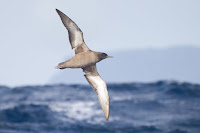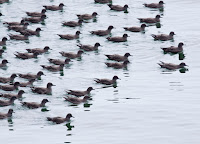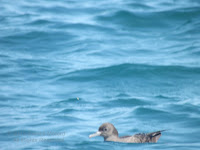SOOTY SHEARWATER
SOOTY SHEARWATER (Puffinus griseus) – (See images below)
DESCRIPTION: The Sooty Shearwater is dark grey with a tinge of brown. The tail is short and the wings long and narrow. The bill is black as well as the eyes. The legs are grey. Sexes are similar. This shearwater is about 38 cm (15 in.) long.
VOICE: https://www.xeno-canto.org/species/Ardenna-grisea
NAME: The name ‘shearwater’ comes from the way these birds fly – the wings are kept stiff, with very few wing beats, with the tips almost touching the water. The Latin genus name ‘Ardenna’ was given to shearwaters in England in the 1600s. The Latin species name ‘griseus’ means ‘grey’. The sooty shearwater is called ‘muttonbird’ in New Zealand.
HABITAT: The sooty shearwater’s main habitat is the open ocean, but they can be seen along the coasts of continents.
DIET: The sooty shearwater feeds on fish and squid, and can dive as deep as 200 feet. They will also follow fishing vessels for offal, and whales.
NESTING: Sooty shearwaters nest in colonies on small islands, in burrows. One egg is laid, which is incubated by both parents. These also both care for the chicks.
DISTRIBUTION: These birds breed on small islands in the South Pacific Ocean, including around New Zealand, Australia and South America. They are a long distance traveler, and their range includes large parts of the ocean around the world. They are occasional visitors to Hawaii.
Distribution map: https://en.wikipedia.org/wiki/Sooty_shearwater#/media/File:Sooty_Shearwater-map-localisation-fr.svg
ON PEI: The sooty shearwater is rare on Prince Edward Island. There have been some sightings at East Point on October 26, 2005.
CONSERVATION: In New Zealand the fledglings are collected for food, at the rate of several hundred thousands per year. Because they breed in burrows in the ground, those birds are particularly vulnerable to predation where unprotected. The bird is considered as ‘near threatened’ as it is also vulnerable to some fishing practices such as long line and trawling.
NOTES: The flying behavior of shearwaters allows them to travel thousands of kilometres while spending little energy.
Shearwaters are part of the tubenoses, seabirds with a highly specialized bill. It is made of plates and the nostrils are inside one of them in the shape of a ‘tube’. These birds drink seawater, and they have glands in their bill to extract the salt from the water. Their nostrils also have a self-defensive feature – when threatened they can spit out a foul-smelling oil from that organ.
The sooty shearwater apparently inspired Alfred Hitchcock for his movie ‘The Birds’. He was living in California at the time, and there has been an incident of thousands of sooty shearwaters poisoned by toxic algae. Before the birds died, some of them behaved strangely, for example throwing themselves into objects.
SIMILAR SPECIES: Short-tailed Shearwater, Wedge-tailed Shearwater, Christmas Shearwater
REFERENCES: http://nzbirdsonline.org.nz/species/sooty-shearwater
http://identify.whatbird.com/obj/620/_/Sooty_Shearwater.aspx
http://www.arkive.org/sooty-shearwater/puffinus-griseus/
https://en.wikipedia.org/wiki/Sooty_shearwater
https://www.audubon.org/field-guide/bird/sooty-shearwater
DESCRIPTION: The Sooty Shearwater is dark grey with a tinge of brown. The tail is short and the wings long and narrow. The bill is black as well as the eyes. The legs are grey. Sexes are similar. This shearwater is about 38 cm (15 in.) long.
VOICE: https://www.xeno-canto.org/species/Ardenna-grisea
NAME: The name ‘shearwater’ comes from the way these birds fly – the wings are kept stiff, with very few wing beats, with the tips almost touching the water. The Latin genus name ‘Ardenna’ was given to shearwaters in England in the 1600s. The Latin species name ‘griseus’ means ‘grey’. The sooty shearwater is called ‘muttonbird’ in New Zealand.
HABITAT: The sooty shearwater’s main habitat is the open ocean, but they can be seen along the coasts of continents.
DIET: The sooty shearwater feeds on fish and squid, and can dive as deep as 200 feet. They will also follow fishing vessels for offal, and whales.
NESTING: Sooty shearwaters nest in colonies on small islands, in burrows. One egg is laid, which is incubated by both parents. These also both care for the chicks.
DISTRIBUTION: These birds breed on small islands in the South Pacific Ocean, including around New Zealand, Australia and South America. They are a long distance traveler, and their range includes large parts of the ocean around the world. They are occasional visitors to Hawaii.
Distribution map: https://en.wikipedia.org/wiki/Sooty_shearwater#/media/File:Sooty_Shearwater-map-localisation-fr.svg
ON PEI: The sooty shearwater is rare on Prince Edward Island. There have been some sightings at East Point on October 26, 2005.
CONSERVATION: In New Zealand the fledglings are collected for food, at the rate of several hundred thousands per year. Because they breed in burrows in the ground, those birds are particularly vulnerable to predation where unprotected. The bird is considered as ‘near threatened’ as it is also vulnerable to some fishing practices such as long line and trawling.
NOTES: The flying behavior of shearwaters allows them to travel thousands of kilometres while spending little energy.
Shearwaters are part of the tubenoses, seabirds with a highly specialized bill. It is made of plates and the nostrils are inside one of them in the shape of a ‘tube’. These birds drink seawater, and they have glands in their bill to extract the salt from the water. Their nostrils also have a self-defensive feature – when threatened they can spit out a foul-smelling oil from that organ.
The sooty shearwater apparently inspired Alfred Hitchcock for his movie ‘The Birds’. He was living in California at the time, and there has been an incident of thousands of sooty shearwaters poisoned by toxic algae. Before the birds died, some of them behaved strangely, for example throwing themselves into objects.
SIMILAR SPECIES: Short-tailed Shearwater, Wedge-tailed Shearwater, Christmas Shearwater
REFERENCES: http://nzbirdsonline.org.nz/species/sooty-shearwater
http://identify.whatbird.com/obj/620/_/Sooty_Shearwater.aspx
http://www.arkive.org/sooty-shearwater/puffinus-griseus/
https://en.wikipedia.org/wiki/Sooty_shearwater
https://www.audubon.org/field-guide/bird/sooty-shearwater
 |
| Sooty shearwater, Australia, J.J. Harrison |
 |
| Sooty shearwaters, CA, Marlin Harms |
 |
| Sooty shearwater, Kaikoura, NZ |